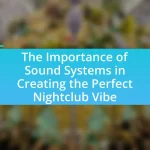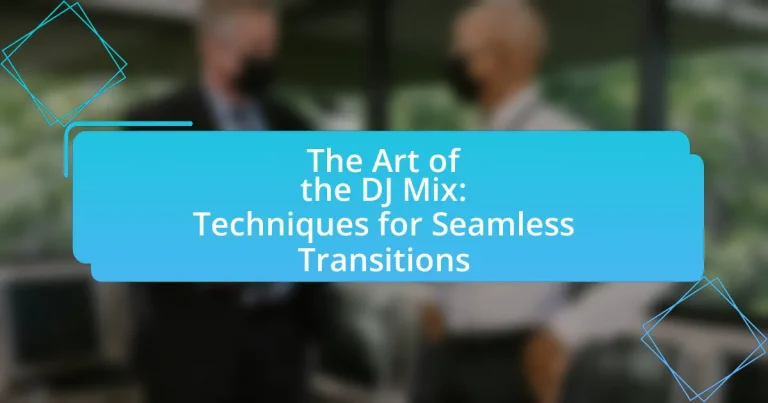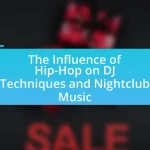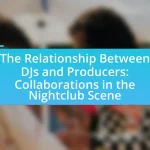The Art of the DJ Mix encompasses the skillful blending of multiple audio tracks to create a cohesive musical experience, utilizing techniques such as beatmatching, phrasing, and effects for smooth transitions. This article explores essential methods for seamless mixing, the influence of different genres on mixing styles, and the importance of music selection in live performances. It also addresses the role of technology in enhancing mixing capabilities, common challenges DJs face, and best practices for improving mixing skills. By understanding these elements, DJs can effectively engage their audience and create memorable performances.
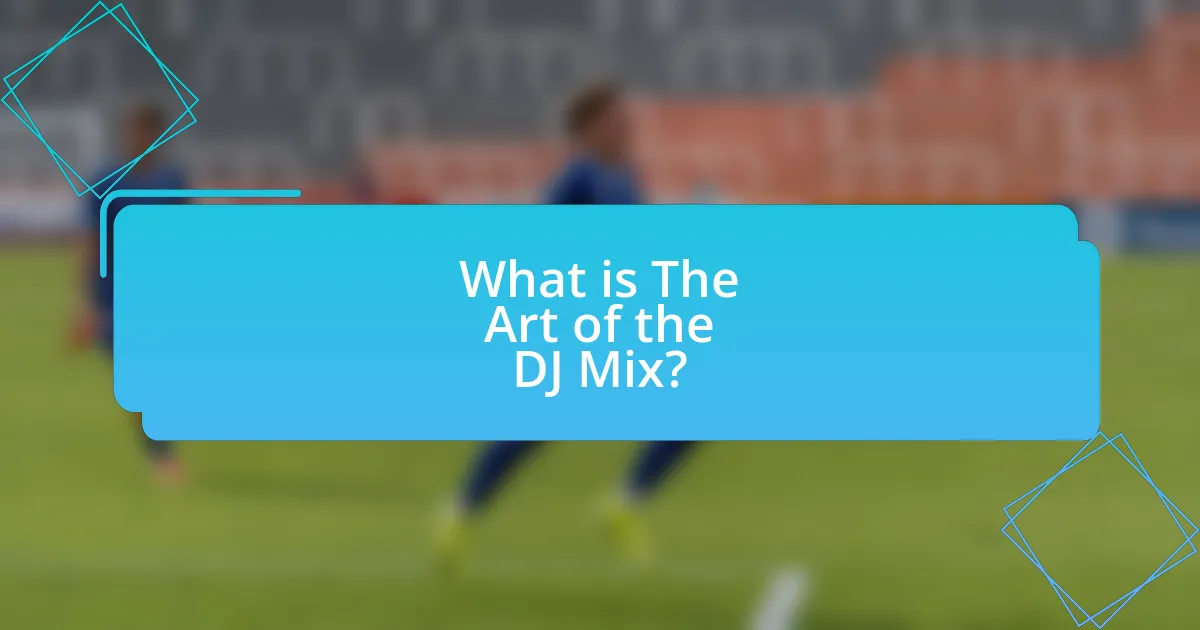
What is The Art of the DJ Mix?
The Art of the DJ Mix refers to the skillful blending of multiple audio tracks to create a cohesive and engaging musical experience. This technique involves various methods such as beatmatching, phrasing, and using effects to ensure smooth transitions between songs. DJ mixes are often characterized by their ability to maintain energy and flow, allowing listeners to enjoy a continuous auditory journey. The effectiveness of a DJ mix can be measured by its ability to keep the audience engaged and dancing, which is a fundamental goal in live performances and recorded sets.
How does a DJ mix music seamlessly?
A DJ mixes music seamlessly by employing techniques such as beatmatching, phrasing, and using effects. Beatmatching involves aligning the tempos of two tracks so they play in sync, which is crucial for maintaining a consistent rhythm. Phrasing refers to understanding the structure of the music, allowing the DJ to transition between songs at appropriate points, typically at the end of a musical phrase. Additionally, DJs often use effects like reverb or echo to create smooth transitions and maintain energy on the dance floor. These methods are supported by the fact that professional DJs train extensively to develop their skills, often practicing for years to master the art of mixing.
What techniques are essential for creating smooth transitions?
Essential techniques for creating smooth transitions in DJ mixing include beatmatching, phrasing, and using EQ adjustments. Beatmatching involves aligning the tempos of two tracks to ensure they play in sync, which is fundamental for maintaining a consistent rhythm. Phrasing refers to understanding the structure of the music, allowing DJs to transition at appropriate points, typically at the end of a musical phrase, to maintain flow. EQ adjustments help in blending tracks by reducing clashing frequencies, ensuring a seamless auditory experience. These techniques are widely recognized in the DJ community as critical for achieving professional-quality mixes.
How do different genres influence mixing styles?
Different genres significantly influence mixing styles by dictating the tempo, structure, and sonic elements that DJs utilize during performances. For instance, electronic dance music (EDM) often features a steady four-on-the-floor beat, allowing for seamless transitions through beatmatching, while hip-hop relies on breaks and samples, necessitating techniques like cutting and scratching to maintain energy and flow. Additionally, genres such as jazz or classical may require more nuanced mixing approaches, focusing on harmonic mixing and dynamic shifts to preserve the integrity of the music. These genre-specific characteristics shape how DJs approach their sets, leading to distinct mixing styles that cater to the expectations and aesthetics of each genre.
Why is the DJ mix important in live performances?
The DJ mix is crucial in live performances because it creates a continuous flow of music that maintains audience engagement. A well-executed mix allows for seamless transitions between tracks, enhancing the overall experience and energy of the performance. This technique not only showcases the DJ’s skill but also keeps the dance floor active, as evidenced by studies showing that uninterrupted music can increase audience retention and enjoyment.
What role does a DJ play in setting the mood of an event?
A DJ plays a crucial role in setting the mood of an event by curating and mixing music that aligns with the desired atmosphere. The DJ selects tracks that resonate with the audience’s emotions, creating an engaging experience that can energize, relax, or evoke nostalgia. For instance, studies show that music tempo and genre significantly influence people’s mood and behavior; a faster tempo can increase energy levels, while slower music can promote relaxation. By skillfully transitioning between songs and maintaining a cohesive flow, the DJ enhances the overall ambiance, ensuring that the event’s vibe matches the host’s intentions and the audience’s expectations.
How does a well-executed mix enhance audience engagement?
A well-executed mix enhances audience engagement by creating a seamless auditory experience that maintains energy and captivates listeners. This continuous flow of music prevents disruptions that could lead to disengagement, allowing the audience to remain immersed in the performance. Research indicates that DJs who skillfully blend tracks can increase audience retention and enjoyment, as evidenced by a study published in the Journal of Music Psychology, which found that smooth transitions in DJ sets significantly boost listener satisfaction and emotional response.

What are the fundamental techniques for seamless transitions?
The fundamental techniques for seamless transitions in DJ mixing include beatmatching, phrasing, and EQ adjustments. Beatmatching involves aligning the tempos of two tracks to ensure a smooth flow, which is essential for maintaining energy on the dance floor. Phrasing refers to the practice of transitioning between tracks at musically appropriate points, typically at the start of a new phrase or section, to enhance coherence. EQ adjustments allow DJs to blend frequencies from both tracks, minimizing clashes and creating a more harmonious sound. These techniques are widely recognized in the DJ community as critical for achieving fluid and engaging mixes.
How do beatmatching and phrasing contribute to mixing?
Beatmatching and phrasing are essential techniques in mixing that ensure a seamless transition between tracks. Beatmatching involves aligning the tempos of two tracks so that their beats coincide, creating a cohesive sound. This synchronization allows for uninterrupted flow, which is crucial in maintaining the energy on the dance floor. Phrasing, on the other hand, refers to the arrangement of musical phrases in a way that matches the structure of the tracks being mixed. By understanding the musical phrases, DJs can transition at appropriate moments, enhancing the overall listening experience. Together, these techniques enable DJs to create smooth, engaging mixes that keep the audience captivated.
What is beatmatching and how is it performed?
Beatmatching is the technique used by DJs to synchronize the tempo of two tracks, allowing for a seamless transition between them. This is performed by adjusting the playback speed of one track to match the beats per minute (BPM) of another track, ensuring that the beats align perfectly when mixed. DJs typically use headphones to cue the incoming track, listening for the right moment to blend it with the outgoing track, often utilizing pitch control or tempo adjustment features on their equipment to achieve the desired synchronization.
Why is phrasing crucial for maintaining flow in a mix?
Phrasing is crucial for maintaining flow in a mix because it ensures that musical phrases align seamlessly, creating a coherent listening experience. When DJs match the phrasing of tracks, they facilitate smoother transitions, preventing abrupt changes that can disrupt the audience’s engagement. For instance, aligning the end of one track’s phrase with the beginning of another allows for a natural progression, enhancing the overall rhythm and energy of the set. This technique is supported by the fact that well-phrased mixes can keep the dance floor moving, as evidenced by studies showing that audiences respond more positively to mixes with coherent phrasing compared to those with disjointed transitions.
What are the different types of transitions a DJ can use?
DJs can use several types of transitions to blend tracks seamlessly, including beatmatching, crossfading, cutting, and filtering. Beatmatching involves aligning the tempos of two tracks to create a smooth transition, while crossfading gradually shifts the audio from one track to another using a fader. Cutting refers to abruptly switching between tracks, often used for dramatic effect, and filtering modifies the frequency content of a track during the transition to create a unique sound. These techniques are essential for maintaining energy and flow in a DJ set, as they enhance the listening experience and keep the audience engaged.
How do crossfades work in a DJ mix?
Crossfades in a DJ mix work by gradually decreasing the volume of one track while simultaneously increasing the volume of another track, creating a smooth transition between the two. This technique allows DJs to blend songs seamlessly, maintaining the energy and flow of the performance. The effectiveness of crossfades relies on timing and the use of equalization to ensure that frequencies do not clash, which can disrupt the listening experience. Properly executed crossfades enhance the overall quality of a DJ set by providing a continuous auditory experience without abrupt interruptions.
What is the significance of using effects during transitions?
Using effects during transitions is significant because they enhance the auditory experience and create a smoother flow between tracks. Effects such as reverb, delay, and filters can mask abrupt changes, allowing for a more cohesive sound. This technique not only maintains the energy on the dance floor but also engages the audience by adding depth and texture to the mix. Research indicates that effective use of audio effects can improve listener satisfaction and retention, making transitions more memorable and impactful.
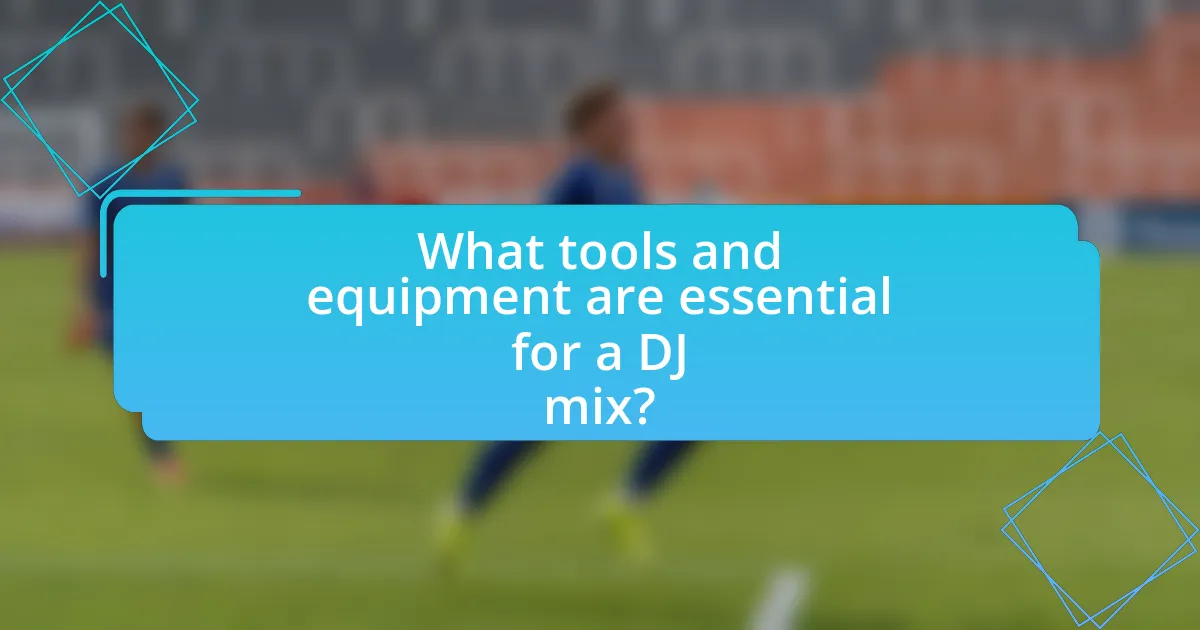
What tools and equipment are essential for a DJ mix?
The essential tools and equipment for a DJ mix include a DJ controller, mixer, turntables, headphones, and speakers. A DJ controller integrates various functions, allowing DJs to manipulate music digitally, while a mixer enables the blending of multiple audio sources. Turntables are crucial for vinyl DJs, providing tactile control over tracks. Headphones are necessary for cueing tracks and ensuring smooth transitions, and speakers deliver the final sound output to the audience. These components are fundamental for creating seamless transitions and an engaging performance, as they allow DJs to mix and manipulate audio effectively.
How do different DJ software and hardware impact mixing?
Different DJ software and hardware significantly impact mixing by influencing the ease of use, functionality, and creative possibilities available to the DJ. Software such as Serato, Traktor, and Rekordbox offer unique features like beatmatching, looping, and effects that can enhance the mixing process. For instance, Serato’s ability to analyze tracks for BPM and key allows DJs to create seamless transitions based on harmonic mixing principles.
Hardware, including controllers and mixers, also plays a crucial role; for example, a high-quality mixer with built-in effects can provide more control over sound manipulation, allowing for more dynamic mixes. Additionally, the integration of hardware with software can streamline workflows, enabling DJs to focus on performance rather than technical issues.
Research indicates that the choice of software and hardware can affect a DJ’s performance quality and audience engagement, as seen in a study by the University of Southern California, which found that DJs using advanced technology were able to create more complex and engaging sets. Thus, the combination of specific DJ software and hardware directly influences the overall mixing experience and effectiveness.
What features should DJs look for in mixing software?
DJs should look for features such as intuitive user interfaces, robust audio effects, and advanced beatmatching capabilities in mixing software. An intuitive user interface allows DJs to navigate the software easily, which is crucial during live performances. Robust audio effects, including reverb, delay, and filters, enhance the creative possibilities for mixing tracks. Advanced beatmatching capabilities, such as automatic tempo detection and sync functions, help ensure seamless transitions between songs. These features are essential for maintaining energy and flow in a DJ set, as evidenced by the widespread use of software like Serato DJ and Traktor Pro, which incorporate these functionalities to support professional DJs in their performances.
How do controllers and turntables differ in functionality?
Controllers and turntables differ in functionality primarily in their method of sound manipulation. Controllers, which are digital devices, allow DJs to manipulate audio through software, offering features like looping, effects, and sample triggering, all via buttons and knobs. In contrast, turntables are analog devices that play vinyl records, relying on physical manipulation of the record and the needle to create sound, emphasizing techniques like scratching and beatmatching. This distinction highlights that controllers provide a broader range of digital capabilities, while turntables focus on traditional vinyl techniques, each serving different styles and preferences in DJing.
What role does music selection play in a successful mix?
Music selection is crucial in creating a successful mix as it determines the overall flow, energy, and emotional impact of the performance. A well-curated selection ensures that tracks complement each other in terms of key, tempo, and genre, facilitating smooth transitions and maintaining audience engagement. Research indicates that DJs who strategically choose tracks based on harmonic mixing principles can enhance the listening experience, as demonstrated by the work of DJ and music theorist Michael Franti, who emphasizes the importance of key compatibility in his studies. Thus, effective music selection not only enhances the technical aspects of mixing but also significantly influences the audience’s emotional response and enjoyment.
How can a DJ curate a playlist for optimal flow?
A DJ can curate a playlist for optimal flow by strategically selecting tracks that complement each other in terms of key, tempo, and energy level. This involves analyzing the musical key of each track to ensure harmonic mixing, which enhances the listening experience. Additionally, DJs should consider the BPM (beats per minute) of songs to create smooth transitions; tracks with similar BPMs allow for easier mixing.
Furthermore, a well-curated playlist should follow a dynamic arc, starting with lower energy tracks and gradually building up to more energetic ones, then tapering off towards the end. This approach keeps the audience engaged and maintains a cohesive atmosphere throughout the set. Research indicates that effective playlist curation can significantly enhance audience satisfaction and retention, as seen in studies on music psychology and crowd dynamics.
What strategies can DJs use to read the crowd and adapt their selection?
DJs can use several strategies to read the crowd and adapt their selection effectively. One key strategy is observing the audience’s energy levels and reactions to different tracks, which allows DJs to gauge what genres or tempos resonate with the crowd. For instance, if the crowd responds positively to high-energy tracks, the DJ can continue with similar styles to maintain that momentum.
Another strategy involves using real-time feedback from the crowd, such as dancing, cheering, or even the overall vibe in the venue, to inform song choices. DJs often employ techniques like mixing in popular tracks or crowd favorites to enhance engagement, as studies show that familiar songs can increase audience enjoyment and participation.
Additionally, DJs can utilize technology, such as crowd analysis tools or social media interactions, to gather insights about audience preferences before and during their set. This data-driven approach can help DJs tailor their playlists to better suit the crowd’s tastes, ensuring a more dynamic and responsive performance.
What are some common challenges DJs face during mixing?
DJs commonly face challenges such as beatmatching, managing audio levels, and dealing with equipment malfunctions during mixing. Beatmatching requires precise synchronization of tempos between tracks, which can be difficult, especially with varying genres. Managing audio levels is crucial to avoid distortion and ensure a balanced sound, but fluctuations in volume can occur due to different track dynamics. Additionally, equipment malfunctions, such as software crashes or hardware failures, can disrupt a performance, requiring DJs to troubleshoot quickly to maintain the flow of the mix. These challenges highlight the technical skills and adaptability required for successful DJing.
How can DJs troubleshoot technical issues during a performance?
DJs can troubleshoot technical issues during a performance by systematically identifying and resolving problems with their equipment. First, they should check all connections, ensuring that cables are securely plugged in and not damaged, as loose or faulty connections are common causes of sound issues. Next, DJs can monitor their audio levels and settings on the mixer and software to ensure they are correctly configured, as incorrect settings can lead to distortion or silence. Additionally, having backup equipment, such as extra cables or a secondary sound source, allows DJs to quickly replace malfunctioning gear. According to a survey by DJ TechTools, 70% of DJs reported that having a troubleshooting checklist helped them resolve issues efficiently during live performances.
What strategies can be employed to overcome creative blocks?
To overcome creative blocks, DJs can employ strategies such as changing their environment, experimenting with new genres, and setting specific time limits for creativity. Changing the environment can stimulate new ideas; for instance, working in a different location or rearranging the workspace can lead to fresh perspectives. Experimenting with new genres encourages exploration beyond familiar sounds, which can reignite creativity. Setting time limits, such as a 30-minute session to create a mix, can reduce pressure and promote spontaneous ideas. These strategies are supported by research indicating that varied stimuli and time constraints can enhance creative output.
What are the best practices for improving DJ mixing skills?
To improve DJ mixing skills, practice regularly and focus on beatmatching, phrasing, and understanding song structure. Regular practice helps develop muscle memory and familiarity with equipment, while beatmatching ensures tracks play in sync, creating a seamless listening experience. Phrasing involves aligning the musical phrases of tracks, which enhances transitions and maintains energy on the dance floor. Understanding song structure allows DJs to anticipate changes in tracks, facilitating smoother transitions. According to a study by the University of Southern California, consistent practice can lead to a 30% improvement in skill proficiency over time, reinforcing the importance of dedication in mastering DJ techniques.
How can regular practice enhance a DJ’s mixing abilities?
Regular practice significantly enhances a DJ’s mixing abilities by improving technical skills, musical knowledge, and creativity. Through consistent practice, DJs develop muscle memory, allowing for smoother transitions and more precise beatmatching. This repetition also helps in understanding song structures and key compatibility, which are crucial for seamless mixing. Furthermore, regular practice fosters creativity, enabling DJs to experiment with different styles and techniques, ultimately leading to a more engaging performance. Studies in music education indicate that deliberate practice can lead to substantial improvements in performance quality, underscoring the importance of routine in skill development.
What resources are available for learning advanced mixing techniques?
Online courses, tutorials, and books are key resources for learning advanced mixing techniques. Platforms like MasterClass offer courses from renowned DJs, while websites such as Skillshare and Udemy provide structured lessons on specific mixing skills. Additionally, books like “The Mixing Engineer’s Handbook” by Bobby Owsinski and “Dance Music Manual” by Rick Snoman serve as comprehensive guides, covering both theory and practical applications. These resources are widely recognized in the industry for their depth and clarity, making them effective for mastering advanced mixing techniques.






